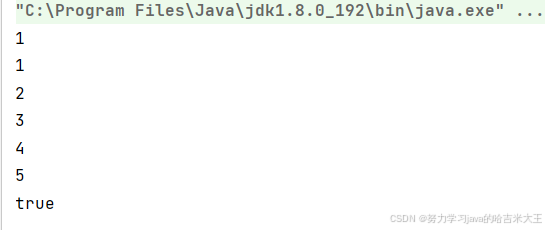1.队列
1.1什么是队列
只允许在一端进行插入数据操作,在另一端进行删除数据操作的特殊线性表称为队列,队列遵循先进先出FIFO(First In First Out)的原则。
入队列:进行插入操作时的一段称为队尾
出队列:进行删除操作时的一段称为队头

在Java中队列时一种重要的数据结构,队列在多线程,任务调度,消息传递等场景中有着广泛的应用。
1.2队列的常用方法
在Java中,Queue是一个接口,可以通过LinkedList,ArrayDeque,PriorityQueue来实现。
Queue的常用方法如下表所示:
|--------------------|--------------|
| 方法 | 解释 |
| boolean offer(E,e) | 将元素插入进队列 |
| E poll() | 将元素从队列中删除 |
| E peek() | 获取队头元素 |
| int size() | 获取队列中有效元素的个数 |
| boolean isEmpty() | 判断队列是否为空 |
代码演示:
java
public class Test {
public static void main(String[] args) {
//LinkedList实现Queue接口
Queue<String> queue=new LinkedList<>();
//PriorityQueue实现Queue接口
Queue<String> queue1=new PriorityQueue<>();
//ArrayDeque实现Queue接口
Queue<String> queue2=new ArrayDeque<>();
//将元素插入进队列
queue.offer("my");
queue.offer("name");
queue.offer("is");
queue.offer("hajimi");
//计算队列中有效元素个数
System.out.println(queue.size());
//获取队头元素
System.out.println(queue.peek());
//计算队列中有效元素个数-->4
System.out.println(queue.size());
//将元素从队列中删除
System.out.println("删除的元素:"+queue.poll());
//计算队列中有效元素个数-->3
System.out.println(queue.size());
//判断队列是否为空
System.out.println(queue.isEmpty());
}
}2.Queue
2.1什么是Queue
Queue是Java中一个非常重要的接口,用于实现队列数据结构。Queue接口本身并不制定底层实现的具体方式,而是由具体的实现类来决定的。Java标准库中提供了多种Queue的实现类,如LinkedList(基于双向链表实现的类),ArrayDeque(基于动态数组实现的双端队列),PriorityQueue(基于优先级堆的无界队列)
2.2 实现一个Queue
队列中既然可以存储元素,那么底层就肯定要有能够保存元素的空间,我们采用链式结构来实现队列。
java
package datastructure;
public class MyQueue {
public static class ListNode{
ListNode next;
ListNode prev;
int value;
public ListNode(int value){
this.value=value;
}
}
//用于记录队头
private ListNode first;
//用于记录队尾
private ListNode last;
//用于记录队列中有效元素的个数
private int size;
//入队列--将元素插入队列中
public void offer(int val){
ListNode newNode=new ListNode(val);
if(first==null){
first=newNode;
last=newNode;
}else {
last.next=newNode;
newNode.prev=last;
last=newNode;
}
size++;
}
//出队列,将元素从队列中删除
public int poll(){
int value=0;
//判断队列是否为空
//如果队列中只有一个元素---链表中只有一个节点---直接进行删除
//如果队列中有多个元素---链表中有多个节点---将第一个节点删掉
if(first==null){
System.out.println("队列中没有元素,无法进行删除操作");
return Integer.MAX_VALUE;
}else if(first==last){
first=null;
last=null;
}else {
value=first.value;
first=first.next;
first.prev.next=null;
first.prev=null;
}
size--;
return value;
}
//获取队头元素
public int peek(){
//判断队列是否为空
if(first==null){
System.out.println("队列中没有元素,无法获取头部元素");
return Integer.MAX_VALUE;
}
return first.value;
}
//计算队列中有效元素的个数
public int size(){
return size;
}
//判断队列是否为空
public boolean isEmpty(){
return first==null;
}
}对我们设计的Queue实现类进行运行测试:
java
public class Test {
public static void main(String[] args) {
MyQueue myQueue=new MyQueue();
myQueue.offer(1);
myQueue.offer(2);
myQueue.offer(3);
System.out.println("获取队头元素:"+myQueue.peek());
System.out.println("队列的长度:"+myQueue.size());
System.out.println("出队列:"+myQueue.poll());
System.out.println("队列的长度:"+myQueue.size());
System.out.println("获取队头元素:"+myQueue.peek());
System.out.println(myQueue.isEmpty());
}
}运行结果:
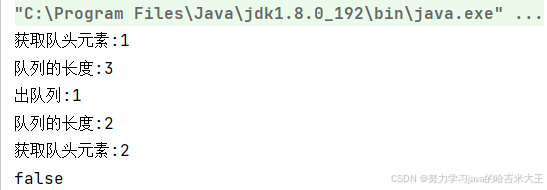
3.循环队列
3.1什么是循环队列
循环队列是一种特殊结构的队列实现,它将数组的头尾相连来解决传统数组队列中"假溢出"的问题。在循环队列中,当队尾指针到达数组的末尾时,会自动循环到数组的头部,而从充分利用数组的空间。
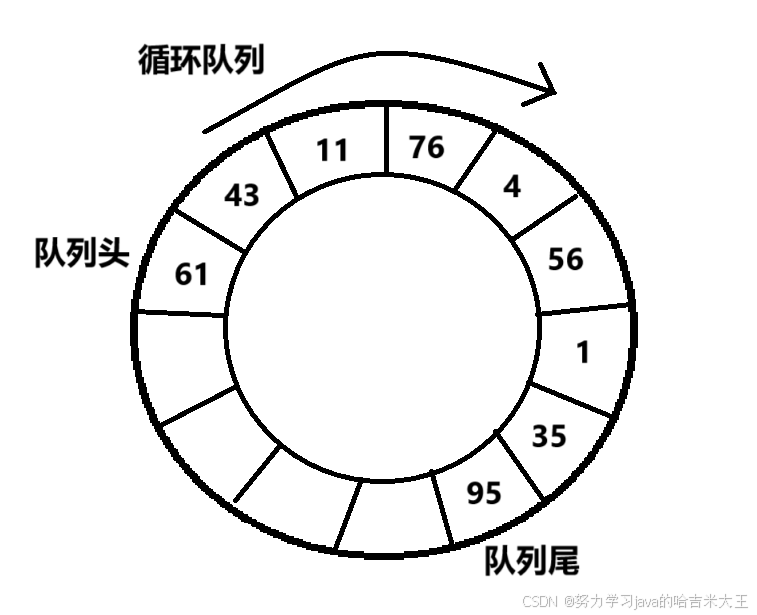
循环队列是基于数组实现的
数组下标循环的技巧:
1.下标最后再往后(offset(表示后移的步数)小于array.length):
index=(index+offset)%array.length
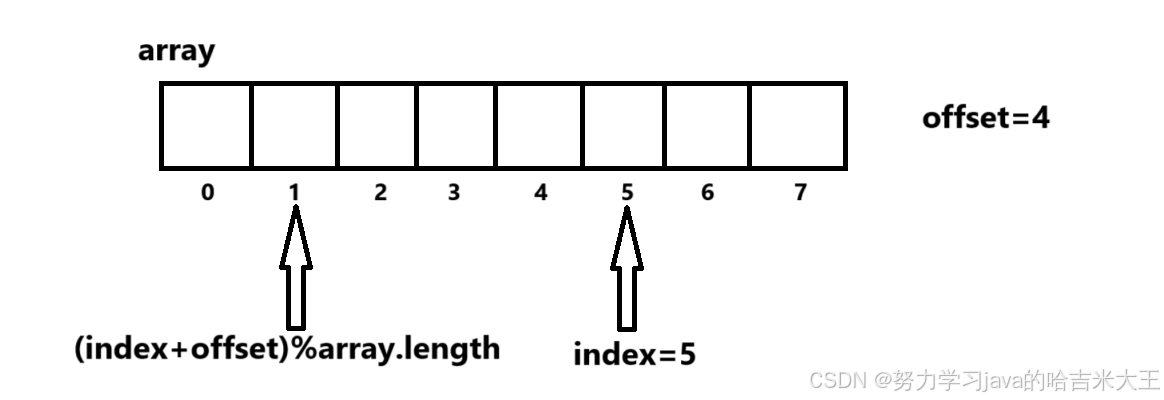
2.下标最前再往前(offset小于array.length):
index=(index+array.length-offset)%array.length

3.2循环队列如何区分空和满
1.通过添加size属性记录循环队列中有效元素的个数,如果size==array.length,表示队列已满,如果size==0,表示队列为空
2.通过保留一个位置(浪费一个空间)来判断是否为满,如下图所示:
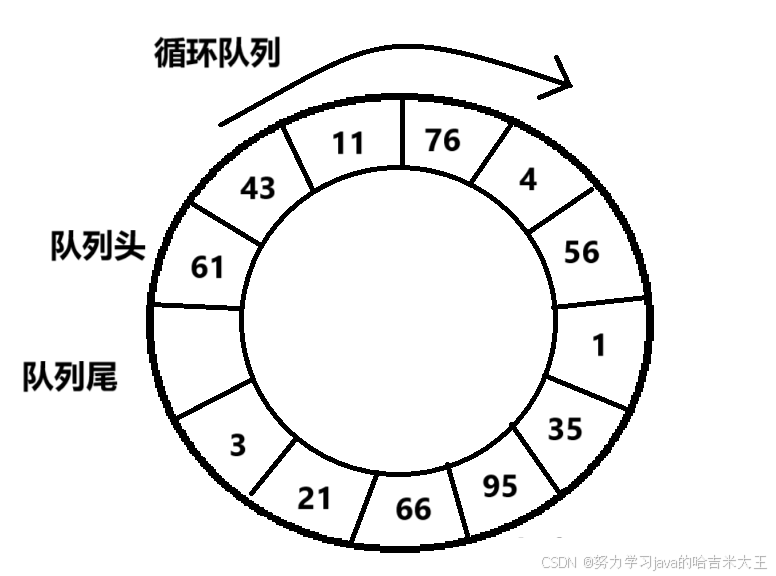
3.3实现一个循环队列
实现循环队列的思路:
通过数组来存储元素,并利用两个指针(front和rear)分别标记队列的头部和尾部,当队列出元素时,front后移,当队列入元素时,rear后移,还要不断判别队列为空或为满的情况。
代码实现:
java
package datastructure;
//采用浪费一个空间的做法实现循环队列
public class CircularQueue {
private int[] elem;
private int front;
private int rear;
//创建一个大小为k+1,实际上有效元素个数最多为k的数组
public CircularQueue(int k){
elem=new int[k+1];
}
//判断队列是否已满
private boolean isFull(){
return (rear+1)% elem.length==front;
}
//判断队列是否为空
public boolean isEmpty(){
return front==rear;
}
//入队列方法
public boolean enQueue(int value){
if(isFull()){
System.out.println("队列已满,无法添加新的元素");
return false;
}
elem[rear]=value;
rear=(rear+1)%elem.length;
return true;
}
//获取队头元素
public int getFront(){
if(isEmpty()){
System.out.println("队列为空,无法获取队头元素");
return Integer.MAX_VALUE;
}
return elem[front];
}
//出队列方法
public int deQueue(){
if(isEmpty()){
System.out.println("队列为空,无法从队列中删除元素");
return Integer.MAX_VALUE;
}
int value=elem[front];
front=(front+1)%elem.length;
return value;
}
//获取队尾元素
public int getRear(){
if(isEmpty()){
System.out.println("队列为空,无法获取队尾元素");
return Integer.MAX_VALUE;
}
//当rear=0,rear-1=-1无法表示数组中的元素,应为elem.length-1
int index=(rear==0)?elem.length-1:rear-1;
return elem[index];
}
}运行测试上述代码:
java
public class Test {
public static void main(String[] args) {
CircularQueue cQueue=new CircularQueue(3);
System.out.println(cQueue.isEmpty());
cQueue.enQueue(1);
cQueue.enQueue(2);
cQueue.enQueue(3);
cQueue.enQueue(4);
System.out.println(cQueue.isEmpty());
System.out.println("从队列中删除元素:"+cQueue.deQueue());
System.out.println("获取队列头部元素"+cQueue.getFront());
System.out.println("获取队列尾部元素"+cQueue.getRear());
}
}结果:
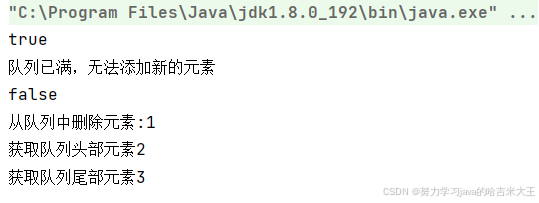
4.Deque
Deque时允许两端都可以进行入队和出队操作的双端队列,deque是double ended queue的简称,表示元素可以从对头出和队尾,也可以从队头入和队尾入

Deque是一个接口,使用时必须创建LinkedList的对象
5.用队列实现栈
队列遵循先入先出FIFO,而栈遵循后入先出LIFO,所以一个普通的队列是无法实现栈的功能的。一个不行,不妨试试两个队列(Queue1,Queue2)。
1.当两个队列都为空时,表示栈为空
2.当元素入栈时,将元素放入不为空的队列中,当元素出栈时,将不为空的队列中的元素出队列,只剩下一个元素,剩下的元素就是要出栈的元素
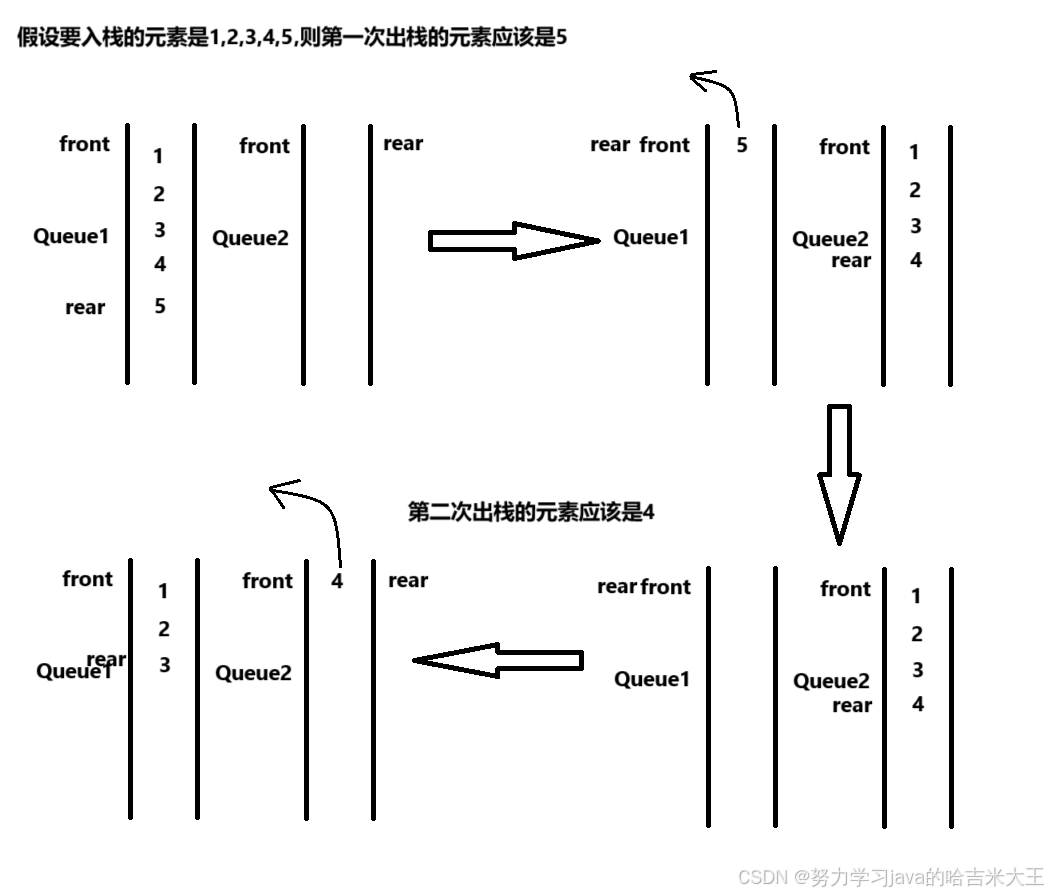
代码实现:
java
package datastructure;
import java.util.LinkedList;
import java.util.Queue;
public class QueueToStack2 {
private Queue<Integer> queue1;
private Queue<Integer> queue2;
public QueueToStack2(){
queue1=new LinkedList<>();
queue2=new LinkedList<>();
}
//入栈操作
public void push(int x){
if(!queue1.isEmpty()){
queue1.offer(x);
}else if(!queue2.isEmpty()){
queue2.offer(x);
}else {
queue1.offer(x);
}
}
//出栈操作
public int pop(){
if(isEmpty()){
System.out.println("栈中没有元素,无法进行出栈操作");
return Integer.MAX_VALUE;
}
int deleteElem=0;
if(!queue1.isEmpty()){
int n=queue1.size();
for(int i=0;i<n-1;i++){
int value=queue1.poll();
queue2.offer(value);
}
deleteElem=queue1.poll();
return deleteElem;
}
if(!queue2.isEmpty()){
int n=queue2.size();
for(int i=0;i<n-1;i++){
int value=queue2.poll();
queue1.offer(value);
}
deleteElem=queue2.poll();
return deleteElem;
}
return Integer.MAX_VALUE;
}
//判断栈是否为空
public boolean isEmpty(){
//当两个队列都为空时,表示栈为空
return queue1.isEmpty()&&queue2.isEmpty();
}
//获取栈顶元素
public int peek(){
if(isEmpty()){
System.out.println("栈中没有元素,无法获取栈顶元素");
return Integer.MAX_VALUE;
}
int value=0;
if(!queue1.isEmpty()){
int n=queue1.size();
for(int i=0;i<n;i++){
value=queue1.poll();
queue2.offer(value);
}
return value;
}
if(!queue2.isEmpty()){
int n=queue2.size();
for(int i=0;i<n;i++){
value=queue2.poll();
queue1.offer(value);
}
return value;
}
return Integer.MAX_VALUE;
}
}运行测试:
java
public class Test {
public static void main(String[] args) {
QueueToStack2 stack2=new QueueToStack2();
stack2.push(1);
stack2.push(2);
stack2.push(3);
System.out.println(stack2.pop());
System.out.println(stack2.peek());
System.out.println(stack2.pop());
System.out.println(stack2.pop());
System.out.println(stack2.pop());
}
}运行结果:
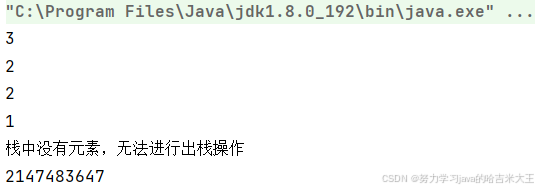
6.用栈实现队列
栈遵循后入先出LIFO,而队列遵循先入先出FIFO,所以单纯使用一个栈无法实现队列的效果,我们可以通过两个栈(stack1,stack2)来实现队列的效果
1.当两个栈都为空时,表示队列为空
2.入队时将所有元素放入栈stack1中
3.出队列时将stack1中的所有元素依次出栈放入stack2中,然后出stack2中的元素即为出队列操作
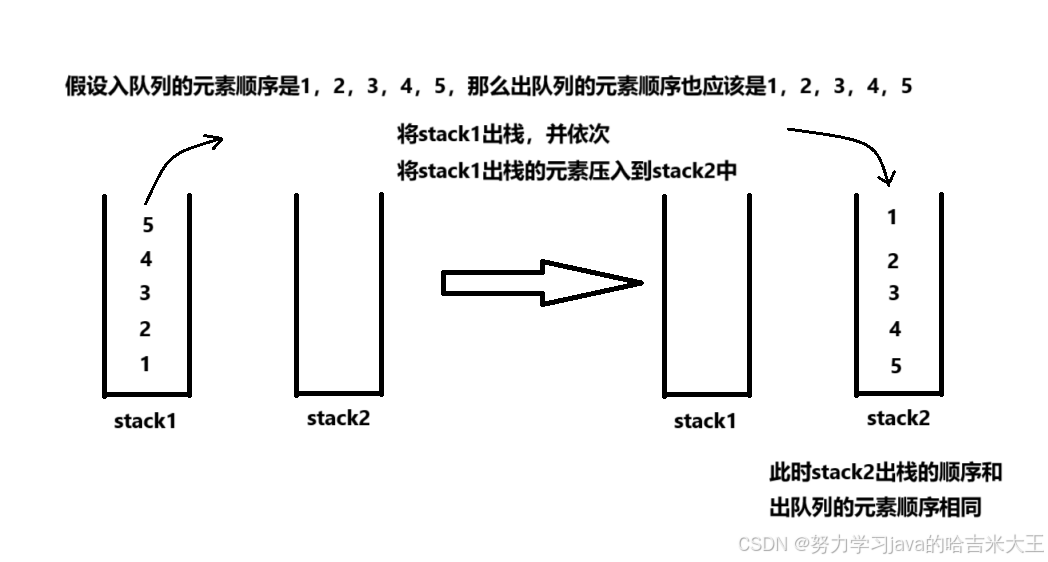
代码实现:
java
package datastructure;
import java.util.Stack;
public class StackToQueue2 {
//扮演队列入队
private Stack<Integer> stack1;
//扮演队列出队
private Stack<Integer> stack2;
public StackToQueue2(){
stack1=new Stack<>();
stack2=new Stack<>();
}
//入队列操作
public void push(int x){
stack1.push(x);
}
//出队列操作
public int pop(){
if(empty()){
System.out.println("队列中没有元素,无法实现出队列操作");
return Integer.MAX_VALUE;
}
if(stack2.empty()){
while (!stack1.empty()){
stack2.push(stack1.pop());
}
}
return stack2.pop();
}
//获取队头元素
public int peek(){
if(empty()){
System.out.println("队列中没有元素,无法获取队头元素");
return Integer.MAX_VALUE;
}
if(stack2.empty()){
while (!stack1.empty()){
stack2.push(stack1.pop());
}
}
return stack2.peek();
}
//判断队列是否为空
public boolean empty(){
return stack1.empty()&&stack2.empty();
}
}运行测试:
java
public class Test {
public static void main(String[] args) {
StackToQueue2 queue2=new StackToQueue2();
queue2.push(1);
queue2.push(2);
queue2.push(3);
queue2.push(4);
queue2.push(5);
System.out.println(queue2.peek());
System.out.println(queue2.pop());
System.out.println(queue2.pop());
System.out.println(queue2.pop());
System.out.println(queue2.pop());
System.out.println(queue2.pop());
System.out.println(queue2.empty());
}
}运行结果:
